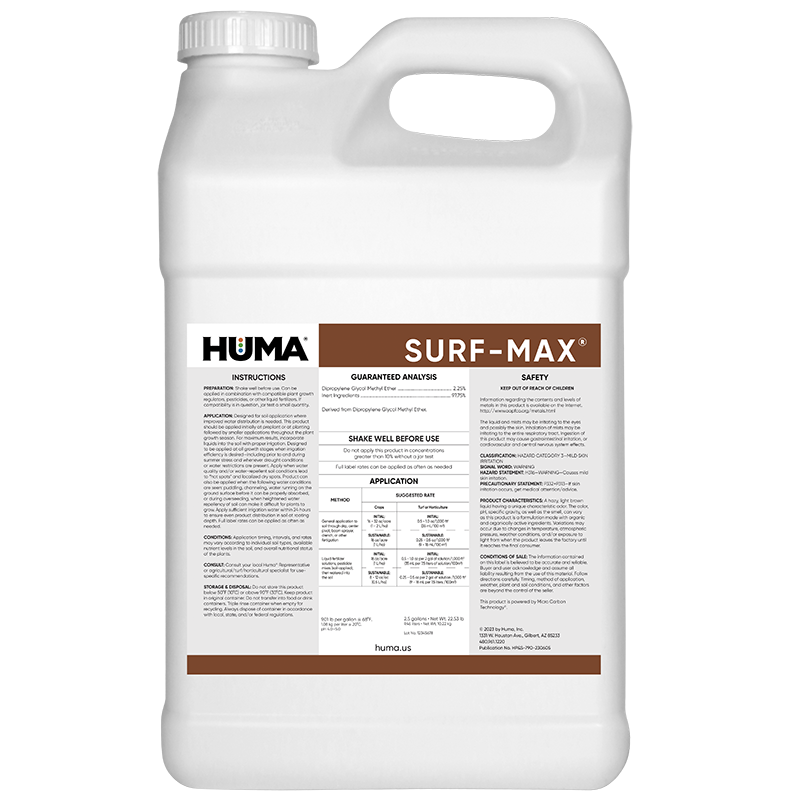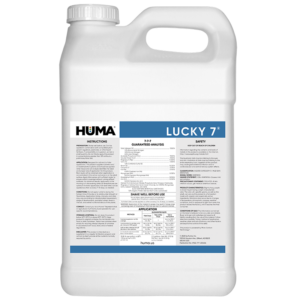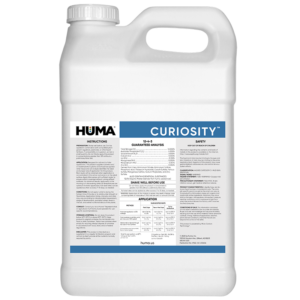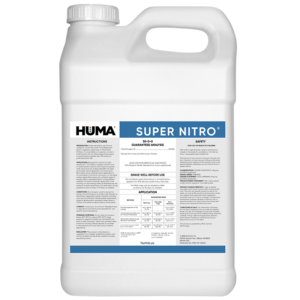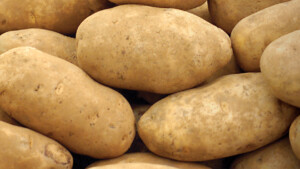SURF-MAX
Benefits of Use:
- Use up to 25% less irrigation water while attaining better water movement through the soil, more effectively providing moisture and delivering water-carried nutrients.
- Due to the complexed Micro Carbon Technology®, the benefits of carbon are carried directly through the soil to the root zone, enabling plants to more effectively absorb nutrients.
- Surf-Max® is fully biodegradable, non-hazardous, non-phytotoxic, and highly compatible with existing chemistries.
- Great for growers of strawberries, tomatoes, peppers, melons, cotton, potatoes fruit trees, olives, lettuce, carrots, blueberries, etc.
Deficiency Symptoms—When to Apply:
- Wherever drought conditions or water restrictions are present; when water conservation is important
- When planting in light-sandy, sandy-loam, or hydrophobic soils
FAQs
Related Videos
Soil Surfactant Surf-Max™ Demonstration A-3: Golf Course Hydration
Dr. Johann Buck demonstrates the effectiveness of SURF-MAX™, the Huma Gro® Turf soil surfactant on golf course turf.
Learn More
Soil Surfactant Surf-Max™ Demonstration A-2: Hydration Bench Test
Dr. Johann Buck demonstrates how SURF-MAX™, the Huma Gro® Turf soil surfactant can help water rapidly penetrate even compressed discs of coir (coconut) fiber.
Learn More
Soil Surfactant Surf-Max™ Demonstration A-1: Thatch Infiltration Bench Test
Dr. Johann Buck demonstrates how SURF-MAX™, the Huma Gro® Turf soil surfactant helps water penetrate hydrophobic turf thatch and spread evenly through the soil.
Learn More
Related Products
Related Case Studies

Huma® Organic Fertilizers Easy to Use, Improve Yield on Organic White Corn
Objective The objective of this field trial was for the grower to evaluate the ease of use and the effectiveness of 4 OMRI-Listed liquid Huma® organic crop nutrition products based on known field deficiencies. Materials & Methods The organic producer provided 2 80-acre plots of organic white corn in eastern Nebraska that was at the

Huma® and Zia Pueblo Farm Corn Project
Background Many small-scale farms (1-2 acres each) are established in Zia Pueblo community near San Ysidro, New Mexico. Huma® Inc. was asked to establish an experimental farm in the tribal community that could demonstrate the usage of beneficial agricultural inputs producing high-yield crop and preserving the health of the soil. Huma® humic-based products stimulate plant
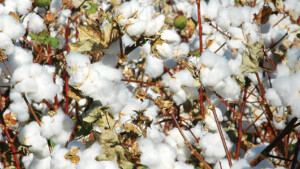
Huma® X-Tend® Increases Cotton Yield With 295% ROI
Background X-Tend® mixed with other fertilizers applied to specific crops has enhanced results with improved plant growth and higher yields. Combining X-Tend® with grower standard products applied to soil and when applied as a single product foliar application could also impact results. Objective The focus of this study was to observe if X-Tend® as a yield enhancing
Related Blog Posts

This Week in Ag #59
“It won’t grow in the bag.” Grandpa never minced words. And that’s how he responded (in frustration) to my dad and uncle whenever they pondered dropping the planter. His philosophy was simple: the moment you can plant, you plant. There’s only so much heat and sunlight Mother Nature offers, so you better take her up on

Beef Is More Than a Business, It’s a Passion.
Beef Is More Than a Business, It’s a Passion. Few professions capture our imagination like ranching. There’s an undeniable romanticism attached to cowboy culture. Taylor Sheridan has made a career depicting it. And let’s be real, they don’t make movies or write songs about pork and poultry producers. Western lifestyle is at a fever pitch. Brands like Ariat and Wrangler are thriving. And so is the cattle industry. Beef prices are enjoying record highs. And when it comes to producing beef, nobody does it better than the American cowboy. US cattlemen produce over 21% of the world’s beef supply – 28 billion pounds annually – ranking #1 in the world. Yet they do it with just 6% of the world’s cattle herd.

This Week In Ag #101
Ask yourself this. Would you really want to be on the other side of a trade dispute with the USA? With all the hysteria over tariffs, that’s a question few seem to be asking. In the global economy, the good ole USA remains the 700-pound gorilla. Boasting a GDP over $25 trillion, the US economy is nearly

